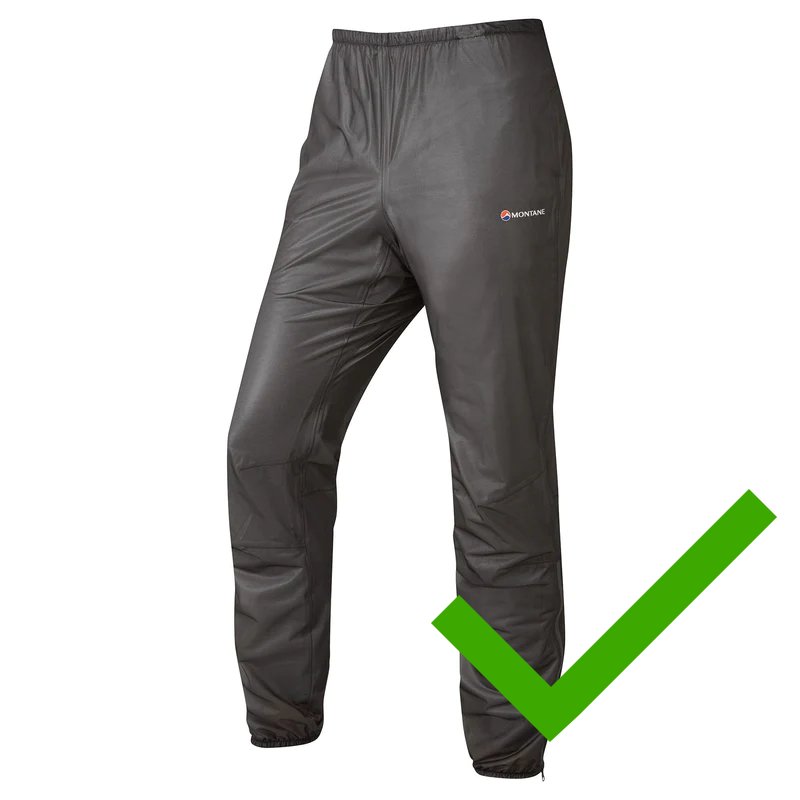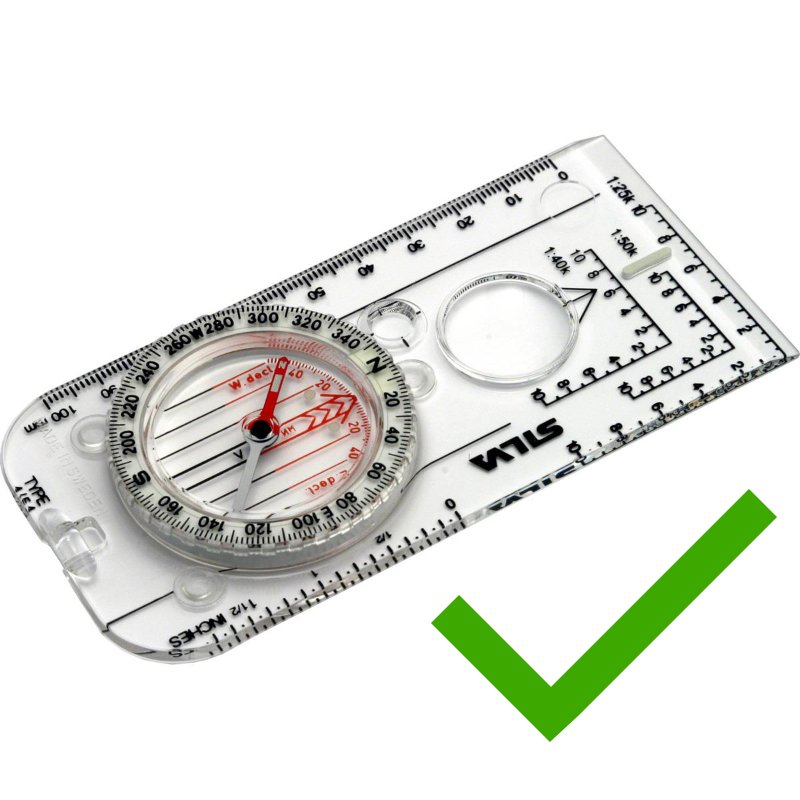Clothing and Equipment Rules and Guidance
Effective from 1st January 2024 across all our events.
Updated 24th March 2024
This article provides both guidance and definitive rules relating to the minimum and mandatory clothing and equipment required for our events and is split into the following sections:
How to read and use this article.
Please ensure you check the precise kit requirements for the event/race that you are participating in, i.e., the Salomon Loch Elide Mòr 10k trail race at Skyline Scotland has different requirements to the SILVA Lakes Traverse 100k. In this example, both races require the participant to have a waterproof jacket and therefore the guidance and rules about waterproof jackets here are relevant to both. However, only the Lakes Traverse requires participants to have a headtorch, and therefore the rules and information here about headtorches are irrelevant to Loch Elide Mòr participants.
The purpose of this article is to help our participants be as prepared as possible for participating in our events.
Please don’t hesitate to contact us if anything is unclear after reading this information.
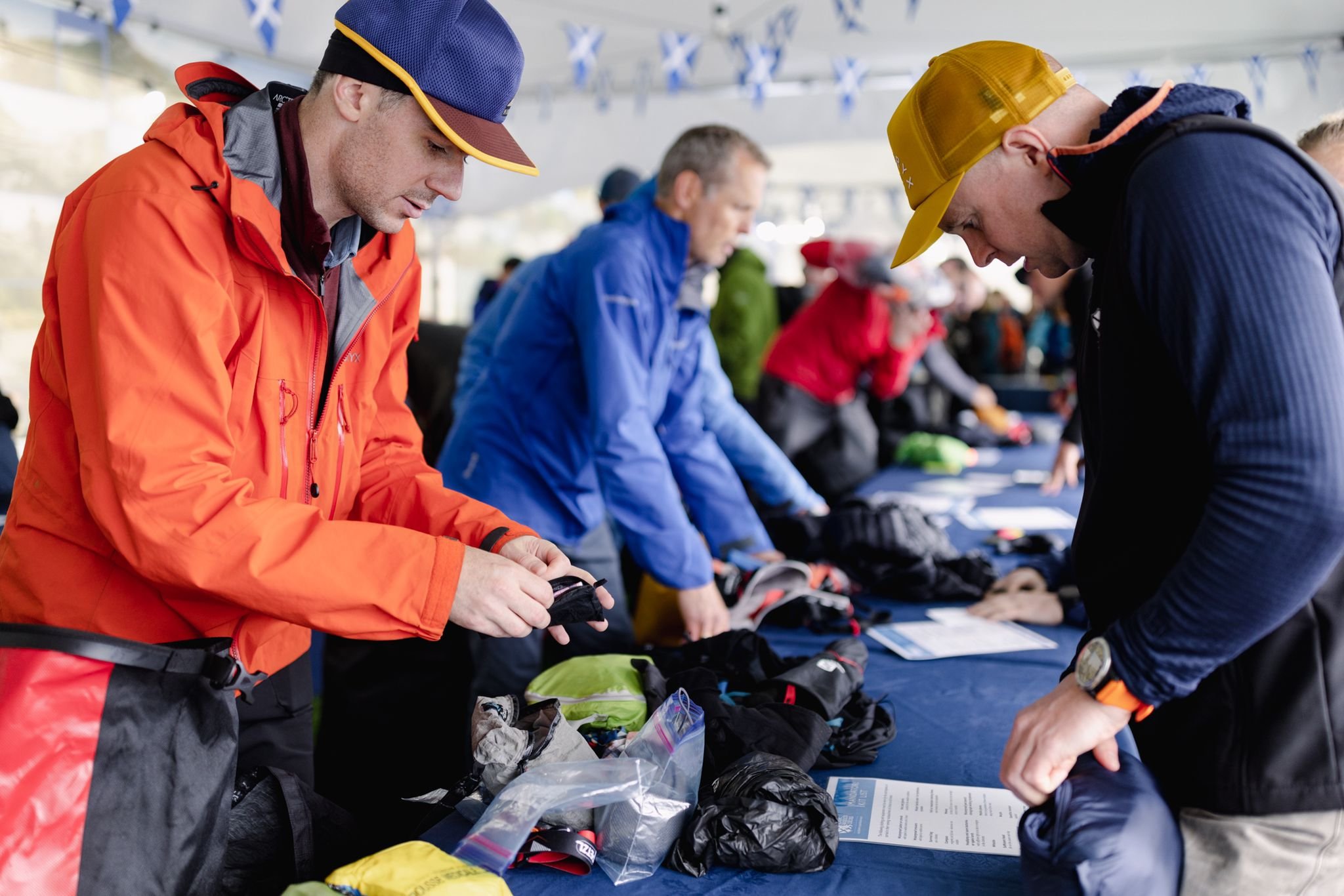
Kit check at the 2022 Cape Wrath Ultra ©No Limits Photography
Introduction
If you would like an insight into the rationale for our approach to the Minimum and Mandatory Clothing and Equipment, please take a few minutes to read our ‘Best Practice Blog: Risk Management and Crisis Communication’ which explores how effective risk management, such as our no-nonsense approach to mandatory clothing and equipment, helps prevent an accident from becoming a disaster.
The overwhelming majority of incidents at our events continue to involve cold participants requiring assistance on the course and/or retiring because they have become cold and/or wet. The theme that links these incidents is that none of these participants ever expected to be in that situation and some additional equipment would have made a substantial difference, and most likely, would have been the difference between continuing or retiring.
History clearly shows that the majority of deaths in fell, mountain, and trail running events result from hypothermia (getting cold). Hypothermia is not limited to the winter months. Our minimum clothing and equipment requirement is focused on this year-round hazard.
Over the years, we have conducted many emergency extractions of participants. In most cases, the participants had slowed down, become cold, slowed down more, and eventually become sufficiently cold and exhausted that an emergency response was required. Or, they had suffered an injury (just a sprained ankle is sufficient) and had become stationary and very quickly (minutes not hours) succumbed to the cold.
All our experience shows that injured runners remain stationary and get cold. Nobody expects to have an accident when they set off, and faster, or more experienced runners are at the same risk as everyone else. Participants should not expect a rescue to occur quickly, and runners will likely need to be able to look after themselves during that potentially lengthy period of time before help arrives.
There are several reasons why we require participants to carry both waterproof trousers and a waterproof jacket, combined with a synthetic warm top:
It enables a slow-moving runner (exhausted and/or with minor injury) to evacuate from the course.
These layers combined enable us, as event organisers, to continue with the event when weather conditions deteriorate because we know that this combination of clothing is effective in cold and wet environments.
Combined with the additional protection of a survival bag, this combination of clothing is effective in stopping a stationary runner dying from hypothermia.
Our clothing and equipment requirements vary depending on the seriousness and remoteness of the race.
Downloadable Checklist
We know that kit and clothing requirements can be a bit confusing so we are providing the following helpful downloadable checklists. Please check the Minimum and Mandatory Kit List carefully for the specifics of what is required for the race or event you are participating in. For the definitive kit list for your race, you can download the checklist PDF from the event website linked below.
Multi-day events in 2025:
For other races, please see individual race websites:
Please check out this excellent video from Scottish Athletics and Trail Running Scotland demonstrating how important the right clothing and equipment is, and how cold runners get when they become stationary.
Kit check
Minimum and mandatory clothing and equipment vary from one event to the next and will usually be checked at registration (Cape Wrath Ultra, Dragon’s Back Race and Northern Traverse) and may also be checked as runners enter the start pen (our Skyline Scotland races) – sometimes both! The minimum clothing and equipment must be carried throughout the event from start to finish.
Our decision about the suitability of any item of clothing or equipment is final. Kit checks are conducted by appropriately experienced event team members, but they do not have the authority to interpret the minimum clothing and equipment list should there be any disagreement about the suitability of a particular item. Only the Race Director or nominated deputy can adjudicate if necessary.
If you have any questions about the minimum clothing and equipment, please read all of the details below, and if still unsure, please do contact us well in advance to clarify the suitability of your item. We will be happy to help. What we will not do, is discuss the purpose or the requirement for a particular item on the kit list, i.e. “I’ve never needed waterproof trousers before…”
Please don’t try to game the system, e.g. bringing ladies’ small waterproof trousers, when you are a large man. Please see our rules about deliberate cheating. Everything you bring must be fit for purpose and that means it must fit you.
Our participant Facebook groups for each event are usually a great place to get informal advice and recommendations, and we would suggest this is the first place to visit for general questions whilst researching possible new purchases. However, please be aware that comments from other people on these groups are not official policy and ONLY Ourea Events can give a definite answer about the suitability of individual items.

Overnight dry bags at the 2021 Cape Wrath Ultra ©No Limits Photography
Part 1
Standard Hill Clothing
Waterproof Material
At all our events, waterproof clothing must have a minimum of 10,000mm hydrostatic head to be suitable to withstand prolonged periods of mountain weather - 15-20,000mm is better. Any items of waterproof clothing that have damage, tears, holes, and/or are held together by duct tape or similar will be rejected at kit check.
Waterproof jacket or smock
Your waterproof jacket must be manufactured, sold, and recognised as a waterproof jacket. This includes having fully taped or welded seams, and it must have a hood. If any of the seams are not sealed in this manner, then the jacket or smock is not fully waterproof. Likewise, if your jacket is not made from a waterproof material, it’s not fit for purpose.
Some high-end jackets, which are sold as waterproof, have laser-cut holes for increased breathability; these are not suitable for our events and will be rejected at kit check.
! Common mistake: having a windproof jacket
! Common mistake: not having taped or welded seams
! Common mistake: a jacket with less than 10,000mm hydrostatic head
Incorrect: windproof jacket (and no hood)
Correct: Montane Spine (men)
Incorrect: laser-cut holes
Correct: Salomon BONATTI TRAIL (women)
Incorrect: 1,500mm hydrostatic head
Correct: Marmot PreCip (men)
Paramo Clothing
We recognise that Paramo has developed a different engineering solution for keeping people warm, dry and comfortable in the mountain environment. We are happy to accept Paramo garments as an alternative to the more widely used waterproof membrane technologies so long as the Paramo garments presented at kit check use Nikwax Analogy Waterproof textiles AND have had a recent DWR treatment. If you have any questions relating to Paramo clothing, please contact us.
Waterproof trousers
Your waterproof trousers must be manufactured, sold, and recognised as waterproof trousers. This includes having fully taped or welded seams. If any of the seams are not sealed in this manner, then the trousers are not fully waterproof. Likewise, if your trousers are not made from a waterproof material, they are not fit for purpose.
! Common mistake: having windproof trousers
! Common mistake: not having taped or welded seams
! Common mistake: trousers with less then 10,000mm hydrostatic head
Correct: Montane Minimus
Incorrect: windproof trousers
Correct: Montane Podium
Incorrect: 1,500mm hydrostatic head
Correct: Marmot PreCip Eco
Spare synthetic WARM top
The spare synthetic warm top can be lifesaving in an emergency (see comments in the introduction).
Synthetic clothing is manufactured from man-made materials such as polyester. The benefit of synthetic materials for UK events (where rain and damp conditions are common), is that these materials retain much of their insulative qualities even when wet. A synthetic layer must be worn under a waterproof jacket to maximize its insulative properties in windy and wet conditions. This is particularly important if the synthetic layer in question is fleece, such as the Protium shown below. A synthetic layer that is also windproof, such as the Prism, is best.
Spare means unworn at kit check and at the day’s start because if you are already wearing it, you have no capacity to layer up in case of an emergency.
The spare synthetic warm top must:
be sealed in a waterproof bag at the start
We recommend:
cover the entire upper trunk including your arms (a hood is best but optional)
have a minimum weight of 300g (this really is the minimum)*
be a single layer and not two lighter weight tops
! Common mistake: Bringing a down layer - because it is not synthetic
! Common mistake: Bringing a woollen layer - because it is not synthetic
! Common mistake: Bringing a layer that is less than 300g
! Common mistake: Bringing multiple layers
! Common mistake: Bringing a gilet layer that does not cover the arms
* The item must weigh 300g for a size male medium style i.e., if you are a size small we will accept a lower weight, and if you are an extra-large, it will need to weigh more.
We do appreciate that our strong position on an entirely separate and spare synthetic warm top will divide opinions and may even be viewed as controversial by some runners. We understand that the preference of individual runners and the safety margin that they are willing to accept whilst running in their own time can vary greatly from our approach.
We pride ourselves on being a gold standard event organiser and we are routinely highlighted as the benchmark that other event organisers measure themselves against and that statutory authorities refer to. As such we have a responsibility to set, what is rapidly becoming, the standard approach for remote mountain running events.
Making a spare synthetic warm top part of the minimum kit at events will significantly reduce the chance of a hypothermia fatality, and it is notable that since we adopted this approach a steady flow of other race organisers have also begun insisting on this approach.
Correct: Montane Prism (men)
Incorrect: does not cover the arms
Correct: Montane Protium Fleece Hoodie (men)
Incorrect: 230g so too light
Correct: Montane Phoenix Stretch Jacket (women)
Correct: Montane Spinon Hoodie (women)
Incorrect: down material so not synthetic
Incorrect: multiple layers to reach 300g
If after reading this, you are still unsure about whether your planned spare synthetic warm top is suitable please ask yourself these questions:
Does it weigh at least 300g?*
Is it made from synthetic material?
Is it spare (i.e., sealed in a waterproof bag at the start of the race)?
Does it cover the arms as well as the trunk?
* The item must weigh 300g for a size male medium style i.e., if you are a size small we will accept a lower weight, and if you are an extra-large, it will need to weigh more.
A Long Sleeve Base Layer
You must carry or wear a long sleeve base layer. This may be worn at the start of the race or carried so that you can layer up if the weather conditions deteriorate. Participants have the discretion to choose the weight and material of their long sleeve base layer. Our intention here is to ensure that the participant wears or carries sufficient clothing for the day ahead, and that their ‘spare synthetic warm top’ is reserved for genuine emergencies.
Hat and gloves
A buff is acceptable as a hat (apart from in the case of cold weather – see guidance on Cold Weather Kit). You will need two pairs of gloves. If the weather is forecast poor (cold and wet), then warm and waterproof gloves are required as per the ‘Exceptional Weather’ rules. Light gloves are acceptable in mild/warm conditions. Please be prepared with a variety of options and check the weather forecast and advise before you set off.
Fell, mountain or trail running shoes
Participants must wear appropriate footwear for off-road running. We recognise that runners have many different preferences when it comes to footwear and we’d like to offer this general guidance. Specialist fell running or mountain running shoes are usually best for our events because of their deep lugs that provide improved grip. Trail running shoes may be appropriate but they usually don’t have sufficiently deep lugs to provide a reassuring grip in a wide variety of situations. We do not consider road running shoes, going barefoot, or minimalist barefoot footwear appropriate for our events.
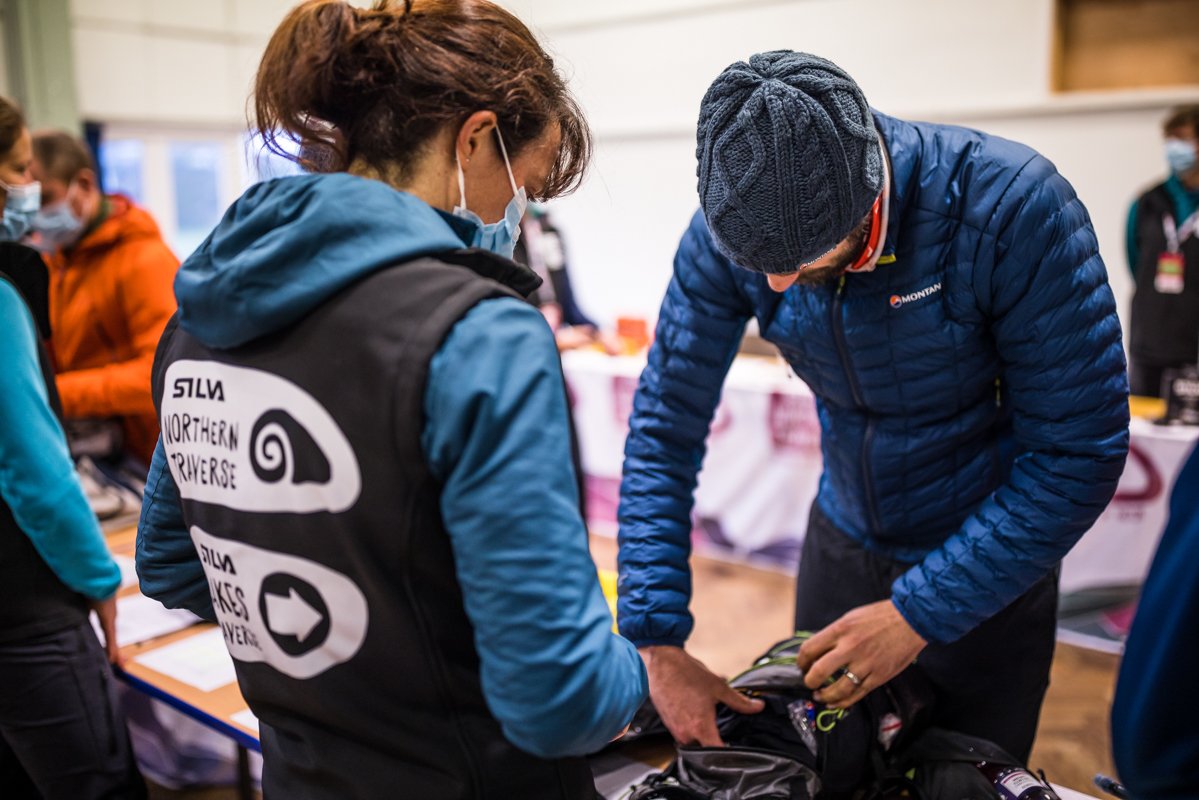
Kit check at the 2022 SILVA Northern Traverse ©No Limits Photography
Part 2
Exceptional Weather Kit
We are being more prescriptive about the type of clothing and equipment that we mandate that participants must carry during periods of exceptionally cold and/or wet, or hot weather. These additional items must be carried as well as the ‘Standard Hill Clothing’ in part 1. Ensuring that participants are well equipped for exceptional weather is important for maximizing the chance that the event can continue despite unfavourable weather conditions.
Whilst we would expect to indicate the requirement to carry this additional clothing in the final event information email, when the weather forecast is marginal or changeable, it is possible that participants may only get a short time warning that this additional clothing is made mandatory. For example:
Northern Traverse: We would notify participants at registration before the start, or we would notify the participants at a Support Point that they would need to carry this kit with them on the next section i.e., participants would need to pack their ‘Cold Weather Kit/Hot Weather Kit’ in their Support Point Bag for the duration of the event.
Lakes Traverse: We would notify participants at registration before the start, i.e., participants would need to travel to the event with their ‘Cold Weather Kit/Hot Weather Kit’.
Great Lakeland 3Day: We would notify participants at registration before the start of Day One, or we would notify the participants at the Overnight Camps i.e., participants would need to pack their ‘Cold Weather Kit/Hot Weather Kit’ in their Dry Bag for the duration of the event.
Cape Wrath Ultra: We would notify participants at registration before the start of Day One, or we would notify the participants at the Overnight Camps i.e., participants would need to pack their ‘Cold Weather Kit/Hot Weather Kit’ in their Dry Bag for the duration of the event.
Dragon’s Back Race: We would notify participants at registration before the start of Day One, or we would notify the participants at the Overnight Camps i.e., participants would need to pack their ‘Cold Weather Kit/Hot Weather Kit’ in their Dry Bag for the duration of the event.
Skyline Scotland: We would notify participants at registration, i.e., participants would need to travel to the event with their ‘Cold Weather Kit/Hot Weather Kit’ kit.
Cold weather kit
The additional ‘Cold Weather’ clothing includes:
A second spare synthetic warm top (this must be hooded, and weigh a minimum of 300g)*
Warm and waterproof gloves
A warm hat and/or waterproof cap**
Full-length tights/trousers
When the ‘Cold Weather Kit’ rule is enacted, the requirement is to have two synthetic warm layers. One must remain spare (i.e. unworn) at the start of the day, and we expect the other is likely being worn at the start.
* This second synthetic warm layer is additional to one required in the standard hill clothing section and must be spare (i.e. unworn) at the start of the day. This synthetic warm top must be:
Hooded
be sealed in a waterproof bag
cover the entire upper trunk including your arms
have a minimum weight of 300g (The item must weigh 300g for a size male medium style, i.e., if you are a size small, we will accept a lower weight, and if you are an extra-large, it will need to weigh more.)
be a single layer and not two lighter weight tops
** During exceptionally wet/cold weather conditions, a buff is no longer acceptable as a hat, and an item designed as a hat (or waterproof cap) is required.
Hot weather kit
The additional ‘Hot Weather’ clothing and kit includes:
Sun hat or cap with a visor shading the face
Additional 1,000ml carrying capacity of the participant’s water bottles / softflasks / Hydration System*
* We recognize different participants require varying amounts of water/fluid each day, if you happen to be someone who drinks less, you do not need to fill your bottles… but you do need to carry this additional capacity, i.e., empty bottles if you must!
Part 3
Hill Equipment
Running rucksack/vest or bumbag
We would like to highlight a growing problem of participants being unable to fit everything in their running vests… and only discovering this at the event! Given that there is the potential requirement to carry the additional Cold/Hot Weather Kit at some of our events, we would recommend a bag with at least 12L capacity… probably more. Your rucksack or vest must be sufficiently large to fit all your standard clothing and equipment into it and the Cold/Hot Weather Kit items. Also, some runners like to stock up on additional food items when passing a shop so you will need additional space for this. Participants are therefore strongly advised not to go for the smallest size pack/vest but to use something with some extra capacity.
We are updating the wording to include ‘Bumbag’ because for some of our trail races at Skyline Scotland, with fewer items on the mandatory kit list, a fellrunning style bumbag would be adequate to carry the minimum and mandatory kit.
As we always say, you should be training with the clothing and equipment you’ll need at the event… and then you’ll know that it all fits in your chosen bag!
Headtorch
You must carry a ‘Headtorch with sufficient battery to last the day/stage/event’ and it must provide sufficient light to be able to navigate in the darkness i.e., get yourself safely off the hill. There is no longer any requirement to carry spare batteries or a spare headtorch and the onus is on the participant to make a judgment about whether a spare battery or spare headtorch would be appropriate for them. We continue to recommend carrying a spare headtorch for any race that might involve the participant being out in the darkness. Please note if your headtorch battery is flat you would no longer be carrying the minimum and mandatory kit.
There is some excellent guidance about how to choose a head torch on the SILVA website here.
! Common mistake: using the 'torch' on a phone either as a main or spare torch
! Common mistake: using batteries up during the event, and then not having spares
! Common mistake: leaving your headtorch in your tent at our overnight events
Food
You must carry sufficient food for the duration of the race/day, and/or sufficient food for the section between support points. Please don’t underestimate this and if in doubt carry more.
! Common mistake: underestimating the amount of food needed for the day’s course
Water bottle SOFT FLASK and/or hydration system
Please see the downloadable kit list for each individual event for the required carrying capacity for water.
Means of payment
Participants must have a ‘means of payment’. This could be cash, credit/debit card, or contactless payment.
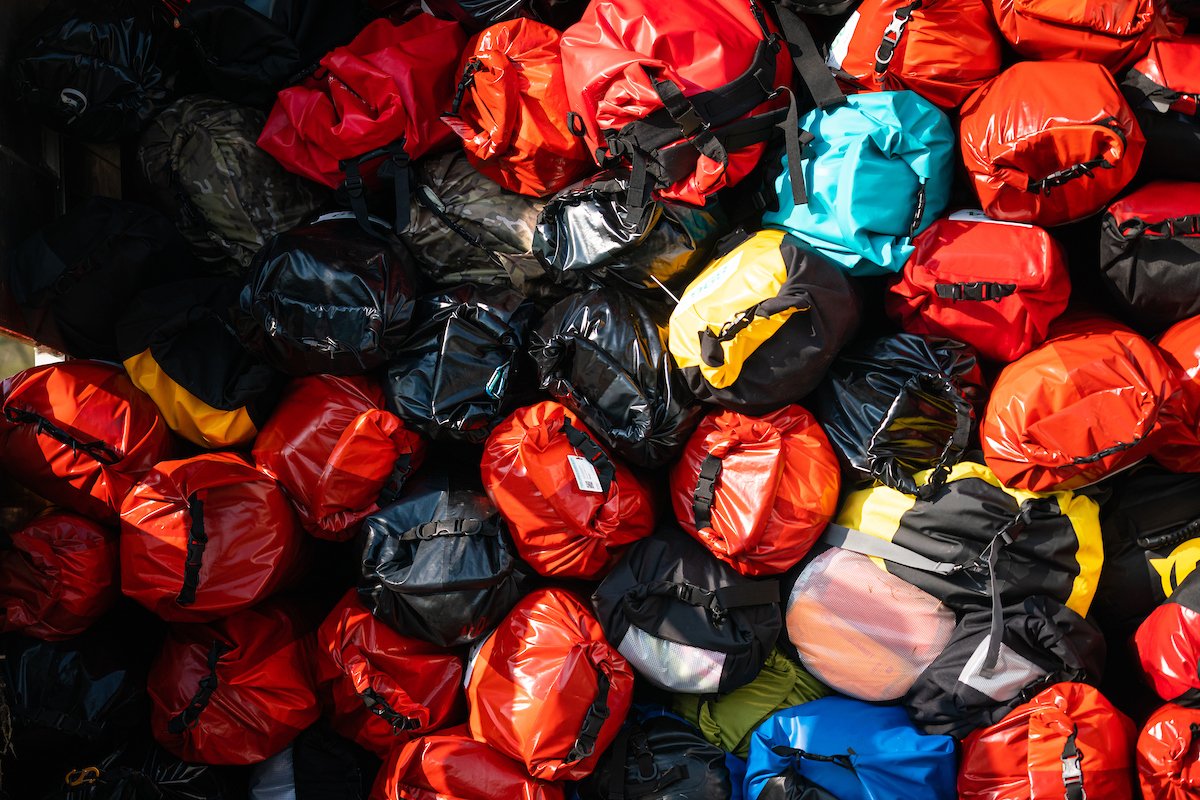
Overnight dry bags at the SILVA Great Lakeland 3Day ©No Limits Photography
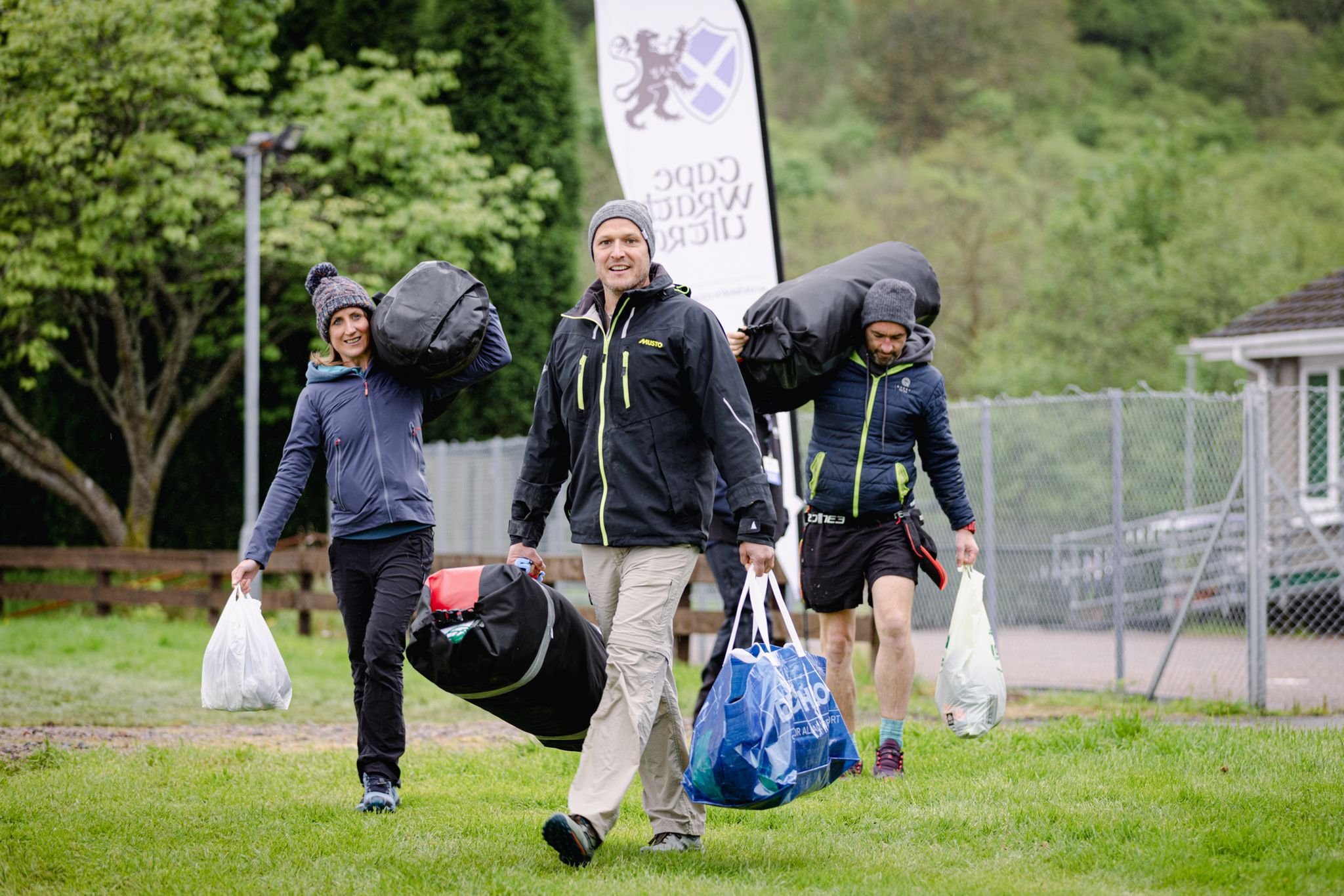
Arriving at the 2022 Cape Wrath Ultra ©No Limits Photography
Part 5
Hill safety equipment
Survival bag
This must be a bag and not a blanket (a blanket is inappropriate and ineffective). The bag should be made from a robust waterproof material. In severe weather you should tear a breathing hole in the ‘foot’ end and get inside the bag as shown below for maximum protection from the weather. You should sit on your rucksack/vest to insulate yourself from the ground.
Whistle
You must carry a whistle. Summoning nearby participants is often the quickest way to obtain help in an emergency. You can either carry a dedicated whistle or a whistle that is integrated into the zip pull of your rucksack or vest, which is common these days.
The recognised emergency SOS signal is six long blasts, followed by 1 minute of silence, and repeat until help arrives.
GPS / satellite tracker (supplied)
We will provide you with an official GPS / satellite tracker (the only exception to this is our shorter trail races at Skyline Scotland). This must be carried throughout the event and full instructions will be provided to you about its use at registration and/or in the pre-event safety briefing.
This GPS / satellite tracker does not provide any navigational information to the participant and is only used for the organisers to track the participant, to raise the alarm in an emergency and provide a public tracking interface.
A GPS tracker being attached to a running rucksack at Skyline Scotland ©No Limits Photography
The YB satellite trackers used for Cape Wrath Ultra ©No Limits Photography
Mobile phone
You must carry a functioning mobile phone, and this must be fully charged at the start of the race, or at the start of each day on a multi-day event. It must remain operational throughout the event, i.e., if your battery is flat you are no longer carrying the minimum and mandatory kit.
You might choose to keep your phone switched off to save the battery and enjoy the quiet of the mountains. However, we would highlight that we have tried phoning participants who have made navigation errors in the past, only to find that their phone is switched off, and we are unable to help them.
Should you become lost, disorientated, or fall behind the cut-off schedule PLEASE ENSURE YOUR PHONE IS SWITCHED ON as it is likely we will be trying to contact you.
We would recommend storing your phone in a waterproof bag as well.

Map reading on day 4 of the 2021 Montane Dragon’s Back Race ©No Limits Photography
Part 6
Clothing and equipment for overnight camps
(multi-day events only)
Over the years we have unfortunately seen participants who have had to retire because their overnight equipment is insufficient. Some items may seem unnecessary but please be reassured that these have been game changing at some editions of our multi-day events in the past.
Overnight dry bag
Please check the overnight dry bag requirements for the event that you are participating in:
Please consider how you pack your dry bag. We would recommend that spare warm clothing and your plate, bowl and mug are positioned at the very top of your bag so that they are immediately available at the end of each day.
A complete change of clothing and shoes
Participants must have a complete change of clothing, including shoes, that can be worn at the overnight camp. Please don’t skimp on this clothing and consider that you might be wet, cold and exhausted at the end of a long day, and you’ll need to sit around in an unheated marquee.
We hope for dry and warm conditions, in which case some flip-flops/sandals would be perfect. However, if the camp is wet and muddy, waterproof shoes will prevent your feet remaining wet after you have finished running and also add warmth and protection.
If space allows in your dry bag, consider taking a second set of waterproof clothing so that you are not walking around in the same saturdated waterproofs as you used on the course. A lightweight poncho is a popular choice with some runners.
Warm sleeping bag
This should be a three-season rated sleeping bag. Remember that tents can become very damp, even wet, if conditions are poor and it is important to bear in mind that tents saturated from overnight rain, must be rolled up and moved to the next overnight camp so have little chance to dry. A three-season rated sleeping bag will help you stay warm at night even in a wet tent.
Warm Jacket
A warm ‘duvet’ jacket (or similar) for staying warm at the overnight camps is essential. This can be synthetic or down. Some runners have taken to bringing an open water swimming ‘dry robe’ for this purpose. This item of clothing must be separate from the spare insulated layer required for your hill bag, i.e., you require two warm jackets because when conditions are very poor, participants inevitably come off the hill with saturated clothing including their spare warm layer.
Sleeping mat
An inflatable mat is best - the thicker and warmer the better!
Plate/bowl, mug and cutlery
We do not provide disposable serve-wear so everyone must have their own plate, bowl, mug and cutlery.
Sun block
Please bring sun block that is Factor 50+ and waterproof.
Midge head net and insect repellent
Note that a mosquito head net will not work!
Personal first aid kit
A small first aid kit must include the following items:
Tick remover
Selection of plasters
Antiseptic ointment
Painkillers (e.g. paracetamol)
We strongly advise AGAINST taking non-steroidal anti-inflammatory drugs (NSAIDs) such as Ibuprofen, Naproxen, and Diclofenac for pain relief during any endurance challenge including our events.
Mandatory items for Cape Wrath Ultra, Dragon’s Back Race, Northern Traverse only!
Kinesiology tape (5cm x 5m)
Small scissors
Personal blister treatment kit:
Sterile scalpel blades x5
Sterile island dressings (6x7cm) x5
Sterile cotton swabs (5x5cm) x10
Inadine dressings (9.5x9.5cm) x2
Disinfection wipes x5
These items will be used by the medical team if you require treatment during the event.










